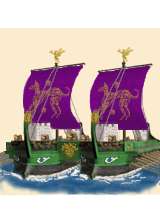Nees Megistai (Huge Poliremes)
 |
Weapons | Defence | Mental | ||||||
|---|---|---|---|---|---|---|---|---|---|
| Primary | Secondary | Armour: | 25 | Morale: | 30 | ||||
| Type: | none | none | Shield: | 0 | Discipline: | normal | |||
| Attack: | 36 | 0 | Skill: | 1 | Training: | untrained | |||
| Charge: | 0 | 0 | Recruitment | Other | |||||
| Lethality: | 1 | 1 | Soldiers: | 13 | Hit Points: | 1 | |||
| Range: | 0 | 0 | Cost: | 20000 | Mass: | 1 | |||
| Ammo: | 0 | 0 | Upkeep: | 9000 | |||||
| Turns: | 4 | ||||||||

The largest of all ancient ships, those extremely expensive vessels personified the strength and power of the owning monarch.
Huge Poliremes
What could better show Your Might than a fleet of huge warships, vastly larger than anyone has ever seen, Basileu? Ships that can carry thousands of mariners, catapults enough for an army and decorations worthy of the royal palace! Sending them to battle might be dangerous as a foolish admiral could lose them, but they do their job even by sitting in port, especially in public view where many people (preferably foreigners) may see them.
The Hellenistic era has also been called the "Age of Poliremes" due to the extensive use of huge warships. It started around 344BC when Dionysios II of Syrakousai employed 6's for the first time. But it was Demetrios Poliorketes who introduced big ships in large numbers - in 306 in the battle of Salamina against Ptolemaios he used seven 7's to form the spearhead of his attack. (One of them was called Antigonis - the feminine form of Demetrios's father's name - this is because ships were 'female' in Hellenic just like in English now.) Later, the construction of ever larger ships began: in 301 Demetrios Poliorketes had 8's, 9's, 10's, 11's, and even a 13. Ships up to 12 became almost common. Even larger were the flagships or the king’s private ships. Historians can't decide if they were used in battle (although Ploutarchos notes of Demetrios' 15's and 16's (launched in 288 BC) "their speed and performance were more remarkable than their size"). But the fact is that 16's, 20's, and even 30's were built to satisfy the desire of Hellenistic kings to have ships larger than those of their neighbours.
Biggest of all was the 40 built by Ptolemaios IV at the end of 3rd century. It was probably a catamaran design as the ship was reported to have 2 prows, 2 sterns and 4 steering oars. It was 429 feet long, 58 feet wide, powered by 4000 oarsmen and could accommodate 2900 mariners (enough crew to man 12 Pentereis!) and a vast assortment of catapulta. The oaring arrangement is uncertain, with some claiming that oars were used on both sides of the hulls, others only the outer. The first would have meant 8-7-5 on each side while the second offers the possibility of either 16-14-10 or 8+8-7+7-5+5 (push+pull).